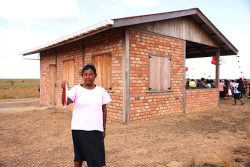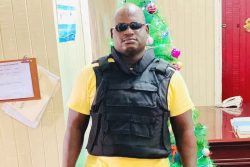On Tuesday evening, Zaharudeen Rozan was arrested for allegedly damaging his neighbour’s fence and taken by the police to the Parika lock-ups. The next morning he was found mortally injured and was taken to the Leonora Hospital where he was pronounced dead on arrival. What happened between his arrest and his death is unclear.
The Police’s version on the day of the death was that at about 8:45 am Rozan was “alive and lying on the floor of the lock-ups…” It added that following questioning of other prisoners in the lock-ups, Rozan was taken for medical treatment at the hospital. It then said that investigations were being conducted by the Police Office of Professional Responsibility (OPR) into the death. On Friday, the police issued another statement saying that the post-mortem examination done on Rozan showed that the injuries he sustained were consistent with an epileptic seizure. It is unclear whether Rozan was prone to epileptic seizures but even if he were the police still have a lot of explaining to do.
The police press release issued on Wednesday was very keen to state that Rozan was alive at the time of discovery. The police force certainly didn’t want to have to deal with the repercussions of a dead person in one of its cells. It needs to be established whether Rozan was indeed alive at the point that he was rushed to the Leonora hospital. Oddly, the police release said that when Rozan was discovered on the floor of the lock-ups, the other prisoners who were there were questioned. At that point Rozan was clearly either dead or near to death. Why was he not rushed immediately to the hospital, leaving the questioning of his fellow inmates for later?
More importantly, Rozan’s relatives said that they were told that he had been banging his head on the wall of the cell on Tuesday and saying strange things. Whether this was indeed so or was intended to provide cover for the police is still to be determined.
What the police need to explain and act upon was the disregard of Rozan in the lock-ups leading to his later discovery either dead or close to death. Whether he was banging his head on the walls or being beaten by inmates, the police in the lock-ups had to be aware of what was happening or they had completely abdicated their responsibilities and obligation towards the prisoner. There must have been an audible commotion in the lock-ups at which point the police should have taken charge of the situation, isolated the prisoner and determined whether he needed immediate medical attention. This was not done.
There is room here for both the OPR and the Police Complaints Authority (PCA) to investigate the conduct of the police in this manner. This is the second incident in a few months on the West Demerara where the conduct of the police has been called into question in the death of a prisoner.
Asif Rahim Khatoon was arrested around 11 pm on November 21, 2014 during a domestic dispute with his wife Soorsattie Chandrapaul. He reportedly told her that the police had beaten him severely during his detention. He suffered a fractured skull, broken jaw and injuries to his stomach. His face was also swollen and he was “vomiting blood,” according to Chandrapaul. His wife witnessed the police brutalizing her husband when they turned up to the scene of the complaint but did not identify the cop/s involved as she did not attend the identity parade that the police organised for her.
Following their assessments of the Khatoon case, the Chambers of the Director of Public Prosecutions (DPP) and the PCA found no grounds for criminal charges against the police in the matter but departmental charges are to be brought against the police for transgressions connected to this case. This has fallen short of public expectations.
Members of the public like Rozan and Khatoon are often subject to brutal behaviour at police stations across the country. It will be one of the shameful legacies of the PPP/C administration over the last 22 years. Notwithstanding all of the international support to the security sector, the Guyana Police Force remains brutal in its interactions with too many members of the public. This is clearly pronounced in some parts like the West Demerara. The torture of a teenager at the Leonora Police Station in 2009 and the shocking promotion this year of the two perpetrators epitomize the worst of the deformed culture of the police force and the police’s intent to sweep these matters under the rug. When this occurs, the signal that is sent by the upper echelons of the force to those beneath is that there is no need to account for these actions and that one could get away with almost anything.
Khatoon was subject to brutality immediately upon the police intervening in the complaint by his wife and later on. What has the police force done or is doing to achieve a qualitative change in the way policemen and women deal with the public? Without underplaying the difficulties that the police face in their every-day tasks, there should be a detailed manual governing the conduct of members of the force and this should be published so that the public could be aware of the standards. It should set out how the police respond to reports of disturbances, the conditions under which any force should be used to subdue a suspect and the obligations policemen and women have towards persons in their custody at the lock-ups and police stations.
Families like those of Rozan and Khatoon have very little chance of securing justice for their grievances and are sent from pillar to post by those in charge. If there was a system and culture of accountability in the GPF, Mr Rozan would not have been failed so starkly by those who were present at the Parika lock-ups.










